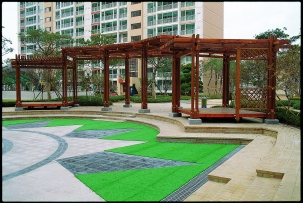
뉴욕타임즈 빌딩 로비 정원

The New York Times Building Lobby Garden
뉴욕의 고밀지역중의 한 지역에 위치한 뉴욕타임즈 빌딩 로비 정원은 상징적인 중정 디자인으로 부각되고 있다. 최첨단 미기후 컴퓨터 시뮬레이션을 통해 제안된 중정이 원예학적으로 지닌 제한점을 찾아내어 최종적으로 세심하게 조정된 설계안을 제시하였다.
렌조 피아노 빌딩 스튜디오와 FXFOWLE Architect’s 설계팀의일부로서 HM White는 뉴욕타임즈 빌딩의 심장이자 정신인 중정 디자인을 이끌었다. HM White는 제안된 중정의 환경적 조건을 이해하기 위해 미기후 전문가들을 고용하였는데, 이들은 모두 3-D 모델링을 통한 미기후 조건을 측정하는 프로그램 분야에서 선구자적인 전문가들이었다. 환경적인 다양성과 극단성을 밝히기 위해 계절에 따른 태양 복사열, 바람, 이용자가 느끼는 친근감의 정도 등을 일정기간 전략적으로 조사하였다. 이러한 과학적인 조사를 통해 얻은 데이터로 중정 내의 재배환경을 예측하여 장기적 지속가능성 확보를 위한 수종결정, 배치 및 준비조건들을 결정할 수 있었다. 이 중정은 고밀화되고 복잡한 타임스퀘어에 대한 반작용으로서, 인간이 만든 구조물의 중심에 자리한 허드슨강 계곡 산림경관의 평화로움과 상징성을 보여주고 있다.
정원은 가장 높은 곳에서 직접적으로 내리쬐는 햇빛을 모으는 자작나무 숲으로 진화하였다. 사초과의 음지성 식물과 자생적인 양치식물의 혼합식재는 다양한 조명과 습한 환경 내에서 지피류의 균일한 피복 및 지속적인 형태 유지를 위해 생육특성을 고려하여 선정되었다.
또한 식재는 계절적인 속성과 시각적 호환성을 고려하여 구성하였다. 지형을 디자인하여 작은 언덕들을 조성하였으며, 유일한 접근로인 목재 산책로는 이 민감한 조경공간에 다리를 놓아주며 관심을 끄는 요소로 작용한다. 최소한의 설계로 확실한 자연의 표현과 절제된 시각적 개념을 담은 단순성을 강조하고 건물 설계 요소와 경쟁하기 보다는 조화를 이루는 설계를 지향하였다. 일시적인 공간으로서, 밤이나 눈 덮인 겨울에도 중정은 새로운 경험을 할 수 있는 조건을 마련해주는 장이 된다.
The New York Times Building Lobby Garden emerges as an iconic courtyard design in one of New York City’s densest neighborhoods. State‐of‐the art microclimatic computer simulations were used in identifying the building’s proposed courtyard horticultural limitations and ultimately informed the carefully calibrated final design. A resultant minimalist design emphasizes a poetic approach that references the Hudson River Valley woodland landscape and creates a restrained visual abstraction, yet strong natural statement harmonizing the building design elements.
As part of Renzo Piano Building Workshop and FXFOWLE Architect’s design team, HM White led the courtyard design ‐ considered the heart and soul of The New York Times building. To understand the proposed courtyard’s environmental conditions, HM White engaged micro‐climate specialists who pioneered a software program that measures micro climatic conditions through 3‐D modeling computer simulations. Seasonal solar radiation, wind and human comfort levels were mapped at strategic times of the year to reveal the environmental variations and extremes. These scientific findings provided data that informed the courtyard design. Growing conditions were revealed to determine species selection, arrangement and planting preparations to ensure long‐term sustainability. As a counterpoint to its dense, bustling Times Square neighborhood, the open‐courtyard’s location reveals a serene, symbolic fragment of the Hudson River Valley woodland landscape at the heart of this man‐made construct. The garden court evolved into a Birch grove clustered where the highest direct sunlight was found to be captured. A mixture of shade loving sedge grasses and native ferns were selected for their ability to establish a uniform ground cover and to perform consistently within a wide range of light and moisture conditions. The planting palette was selected for its year‐round seasonal attributes and visual compatibility. The “hillocks” provide sculptural relief and draw attention to the solitary timber walk that bridges over its sensitive landscape as the only means of access. The minimalist design emphasizes a bold simplicity to create a restrained visual abstraction, yet strong natural statement that harmonizes rather than competes with the building’s design elements. As a temporal space, both evening and snow‐covered winter conditions stage new experiences of the garden court.
A layered web of planting infrastructure knits the garden with the building and the ground while also supporting the development of healthy soil biology. The garden contains a computer‐controlled irrigation system (with an integrated water de‐chlorination system) that includes subsurface irrigation for the trees and surface mist irrigation for the woodland carpet, which also assists in cooling the garden during hot summer periods. Engineered soil profiles reflecting endemic growing conditions respond to the courtyard’s bedrock base and were designed to meet the planting’s biological needs, ensuring long term sustainability. 25‐year‐old Birch trees were selected and pre‐purchased early in the design process to implement advance root pruning procedures and biologically based root inoculations to improve acclimation and minimize potential transplant shock. Strict scheduling and coordination with building construction, street closure, tree delivery and assembling the largest single crane in the NY‐Metro region was required to hoist each tree weighing 32,000 pounds over the 70‐foot building facade into pre‐determined specific locations and elevations within the courtyard.
Landscape Architects _ HM White Site Architects(Collaboration with Cornelia Oberlander Architects)
Architects _ Renzo Piano Building Workshop and FXFOWLE Architects
Microclimatic _ Ekistics Planning & Design
Arborist / Soil Food Web Specialist _ Tree Wise Organics
Nurseries _ High Ridge Farms Nursery
Client _ The New York Times Company
Location _ 620 Eighth Ave, New York, New York
- HM White Site Architects · HM White Site Architects
-
다른기사 보기
www.hmwhitesa.com




















